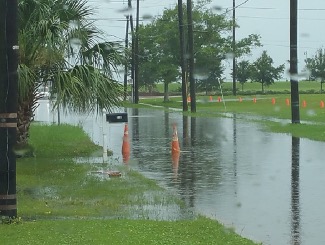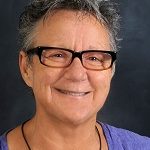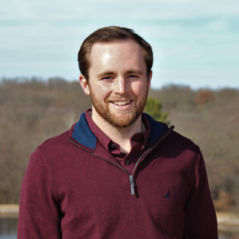Apply now to join our next cohort of Community Science Fellows and Community Leads!

This project will produce a visual and scientific report outlining the current infrastructure of the flood plain area and the potential environmental and economic impacts of additional construction within the historic and flood-risk community. The report will be used as an educational campaign for community member and as scientific evidence to protect the community being forced out due to excessive flood damage and insurance costs.
The Tanyard neighborhood is a historic, predominately African-American community situated west of downtown Pensacola, FL. The previously diverse community with a flourishing industry, creole cottages, and shotgun homes is now at high risk of gentrification and fill-and-build development. Public and private construction in and around the community has filled in existing flood plains and floodways that historically shuttled rain water, salt water, and sewage into the bay, but now deposit the water into the homes of Tanyard community members. Outdated drainage infrastructure allows heavy rain water to mix with sewage making the flooding not only damaging to the house’s infrastructure but to the health of the residents.
The city of Pensacola is currently accepting submittals for the redevelopment of local green spaces, 19-acre site that helps mitigate the frequent floodwaters. The new construction, called “the big build,” is a public/private development situated upon an old Emerald Coast Utilities Authority sewer treatment plant, nicknamed “Ol’ Stinky.” Previously, the Tanyard neighborhood association, founded in 2005 to address concerns related to the rapid gentrification of the neighborhood, industrial development, ongoing contamination, and flooding, has worked to bring awareness and concerns from the community to the local government. In recent months, the association has turned its back on the community members crumbling under the pressure of continuous flooding in support of the big build. The goal of this project is to determine and present to the local government the potential damage and increased flooding within the Tanyard community as a function of the new construction on and around the flood plain areas.
The community leaders seek to address two main objectives through the Thriving Earth Exchange project: 1) to assess the vulnerability and potential neighborhood impacts of the “big build” and 2) design and implement media campaign in order to bring awareness to this issue.
The hope of a scientific report generated by an expert community scientist would be to highlight the areas most effected by current flooding and the potential increased damage as a result of construction on existing greenery. The report could be used as scientific evidence to present ecological, economical, and human health arguments to the local government in opposition of the current construction plans.
A complimentary image-heavy media campaign has the potential to inform the local community members about the detrimental impacts of the construction on existing greenery. The use of photos and videos can provide tangible and physical weight to the findings presented in the community scientists generated report. The local government has pointed to a lack of attendance and input by the local community at open hearings. A media campaign would help bring power to a community whose voice is currently being overshadowed and underrepresented.

Gloria G. Horning, Ph.D. is a social and environmental justice advocate based in Pensacola, Florida. She has nearly thirty-years’ experience in working with disenfranchised communities that continue to be plague by unregulated landfills in the historic African-American communities–Wedgewood, Rolling Hills and Olive Heights. Currently Dr. Horning is fighting for flood relief in the oldest neighborhood in Pensacola — The Tanyard. Dr. Horning holds a Ph.D. from Florida State University. Her dissertation focused on environmental issues facing small communities’ and the health impacts on the citizens.

Ms. Barbara Albrecht, has 30 years of experience in bioassay labs, lead to chasing chemicals through ecological systems and finally to human exposure via conducting environmental risk assessments. She is actively engaged with citizen science programs and has served as an advocate for many communities as they address local environmental concerns. Barbara currently leads the Bream Fishermen Association and is the director of the Panhandle Watershed Alliance. Through the activities of citizens and groups such as Audubon and the Native Plant Society and this organization, she hopes to bring appreciation, awareness, conservation, low impact restoration, and appropriate management to local area waters and all the user groups.

Chris Jernigan is a fourth year Chemistry PhD candidate at the University of Wisconsin – Madison. His research focuses on the chemical interactions and cloud-forming properties of molecules in the air over oceans. Chris received a B.S. in chemistry and a certificate in Energy and the Environment from Duke University in Durham, NC. He facilitates his passion for science communication and outreach by serving as a Science Olympiad coach and as a volunteer at the Wisconsin Science Festival.
Sabrina Chapa, Anthropocene Alliance

Alexis Hidalgo lives in Miami, so sea-level rise is especially meaningful to her. She’s a graduate of the University of California-Berkeley with degrees in Environmental Science and Environmental Politics. She has interned with the House of Representatives Select Committee on the Climate Crisis and was a SustainUS Delegation Member at the World Bank Meetings.
 Anthropocene Alliance is the nation’s largest coalition of frontline communities fighting for climate and environmental justice. AA leaders face myriad challenges: damaged property, homelessness, debt, and unaffordable insurance. Supported by outstanding partner organizations that contribute expertise, grassroots leaders have successfully halted developments in flood prone areas; planned and instituted green infrastructure; organized home buyouts; and promoted clean-ups in areas that flood.
Anthropocene Alliance is the nation’s largest coalition of frontline communities fighting for climate and environmental justice. AA leaders face myriad challenges: damaged property, homelessness, debt, and unaffordable insurance. Supported by outstanding partner organizations that contribute expertise, grassroots leaders have successfully halted developments in flood prone areas; planned and instituted green infrastructure; organized home buyouts; and promoted clean-ups in areas that flood.
(c) 2024 Thriving Earth Exchange